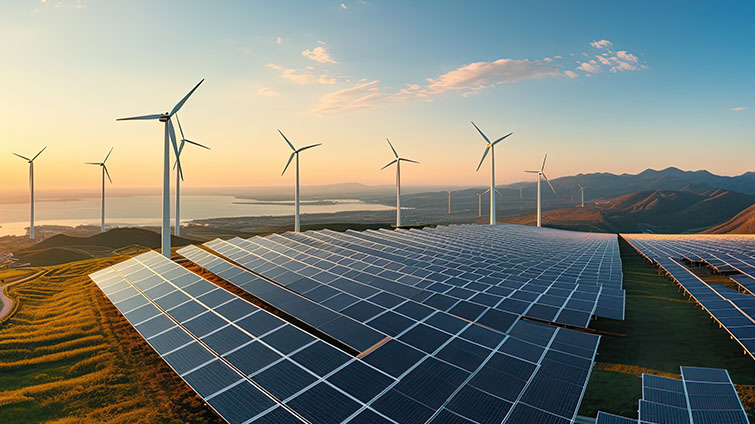AI data centers power up amid energy constraints
Published: Thursday, November 06, 2025 | 08:00 am CDT
AI data centers turn toward on-site power generation
In the race to expand computing capacity for artificial intelligence, data center companies are increasingly building their own on-site power generation rather than waiting for the grid to catch up. This is mainly the case in states with deregulated energy markets, such as Texas and Oklahoma, where data center operators meet few constraints on their ability to add capacity “behind the meter.”
In the face of long lead times on industrial-scale gas turbines, these companies are piecing together solutions with whatever equipment they can find. This can include smaller gas turbines that are usually used for emergency or backup power, as well as solar panels and batteries for storage.
Even though solar has become more expensive due to U.S. tariffs and declining federal subsidies, it’s still seen as a fast and reliable way to get new data centers up and running. If it enables them to add computing capacity rapidly, the AI companies are proving willing to foot the extra cost.
Building a large data center with on-site energy generation and storage can require hundreds of shipments per day. C.H. Robinson can support these projects with tailored solutions, including logistics planning and real-time visibility.
Data center growth drives renewed interest in nuclear power
Nuclear power is increasingly seen as another viable way to meet the AI sector’s growing energy demands. It is stable, predictable, and capable of generating power over 90% of the time. Nuclear energy is also nearly carbon-free, making it well-aligned with corporate sustainability goals.
Nuclear energy accounts for nearly 20% of electricity generation in the United States. Since May of this year, the U.S. administration issued a series of executive orders to reinvigorate the U.S. nuclear industry, with the goal of quadrupling capacity by 2050.
To circumvent decade-long lead times for the construction of new reactors, tech companies such as Google and Meta have ambitions to restart decommissioned nuclear power plants. Another potential avenue toward scaling up nuclear energy lies in small modular reactors, which would be faster to build. However, no commercial versions are operational yet.
If tech companies succeed in restarting decommissioned plants or deploying small modular reactors, it could lead to major infrastructure projects, increasing demand for transport of heavy equipment, reactor components, and construction materials.
Russian oil sanctions
Russia’s two biggest oil companies, Rosneft and Lukoil, have been hit with U.S. sanctions with the intent of bringing an end to the war in Ukraine. The companies account for a combined 5% of global oil production. Chinese state oil majors have suspended Russian oil purchases and refiners in India, the largest purchaser of seaborne Russian oil, have dramatically cut imports from Russia.
With OPEC’s November 2 decision to not increase output, the sanctions are tightening global oil supply, driving up fuel costs, and creating volatility in energy markets. U.S. diesel prices have increased since the announcement, impacting the freight sector through higher operating costs for carriers. This could lead to rate increases, tighter margins, and reduced capacity—especially in long-haul and international shipping lanes.
Tariff updates
- Reciprocal tariffs: On November 5, the U.S. Supreme Court heard oral arguments in the case that will determine whether the president has the authority to impose tariffs by declaring a national emergency. Reciprocal tariffs on imports from most countries were established under the International Emergency Economic Powers Act (IEEPA), as were tariffs imposed on goods from China, Mexico, and Canada with the goal of reducing the flow of fentanyl. If the Supreme Court determines the president does not have this authority, it’s uncertain whether refunds will follow. A ruling is expected by early to mid-December.
- China: An interim U.S. deal with China announced in writing November 1 provided some relief for importers. It included a decrease in the drug-related tariff from 20% to 10%, set the reciprocal tariff at 10% for a full year instead of it rising to 34% on November 10, and averted the threat of an additional 100% tariff. These measures are scheduled to go into effect November 10. See the White House fact sheet for more details.
- Canada: On October 25, the U.S. administration said it would add 10% to tariffs on goods from Canada. It’s not clear when this measure will take effect and which goods will be affected. Most Canadian exports to the United States are exempt from tariffs under the United States-Mexico-Canada Agreement (USMCA). Goods not covered by USMCA have been subject to a 35% tariff since August 2025.
- South Korea: As part of its Oct. 29 tariff deal with the United States, South Korea pledged $350 billion in investments in the American economy. Among the target sectors are LNG and grid infrastructure.
- New Asia deals: The United States reached tariff deals with Malaysia, Thailand, and Vietnam. Each country agreed to eliminate tariffs on U.S. goods, with some exceptions. Imports to the U.S. from Malaysia and Thailand will face a 19% tariff, and those from Vietnam 20%. In each case, exceptions apply.
 Download slides
Download slides